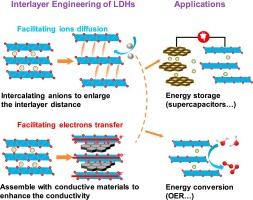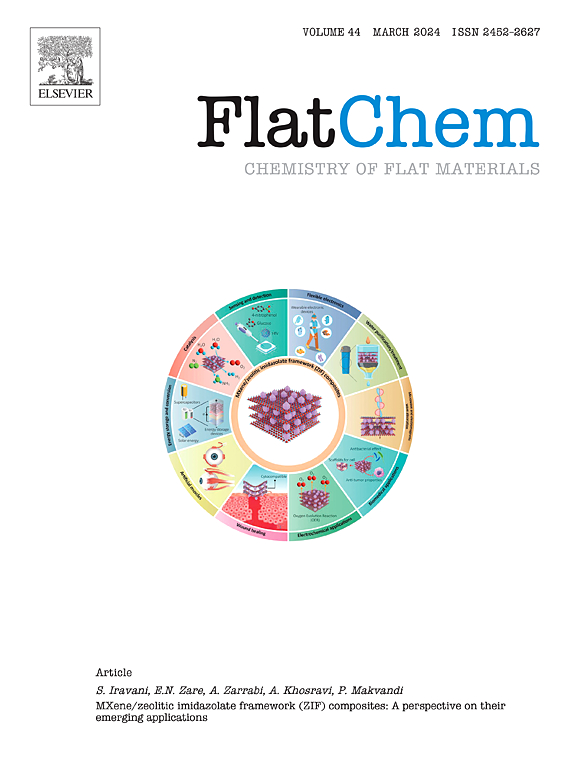用于先进能量存储和转换的层状双氢氧化物层间工程
IF 5.9
3区 材料科学
Q2 CHEMISTRY, PHYSICAL
引用次数: 0
摘要
层状双氢氧化物(LDHs)是一种极具吸引力的功能材料,它既可用于理论容量高的能量存储,也可用于活性位点丰富且可调的能量转换。为了提高能量存储和转换性能,人们开发了许多策略,如形态和成分调节、缺陷工程和层间工程。我们重点研究了用于先进能源应用的 LDH 层间工程。阴离子插层进入类青金石层廊可扩大层间距离,从而增强质量/电荷转移和活性位点暴露;与导电材料进行剥离-组装可提高电子转移能力和活性位点比例,从而有效提升其在能源应用中的性能。在这篇综述中,我们总结了通过阴离子插层和剥离-组装实现 LDHs 层间工程的进展,以及所改善的能量存储和转换性能。我们还概述了层间工程如何调整 LDHs 的性能,并讨论了主要挑战和未来方向。本综述揭示了先进 LDHs 材料在能量存储和转换方面的应用前景,尤其是在超级电容器和氧进化电催化方面。本文章由计算机程序翻译,如有差异,请以英文原文为准。

Interlayer engineering of layered double hydroxides for advanced energy storage and conversion
Layered double hydroxides (LDHs) are very attractive functional materials either for energy storage due to the high theoretical capacities or for energy conversion due to the abundant and tunable active sites. Many strategies have been developed to improve the energy storage and conversion performance such as morphology and composition regulation, defect engineering and interlayer engineering. We focus on the interlayer engineering of LDHs for advanced energy applications. Anion intercalation into the galleries of brucite-like layers can expand the interlayer distance to enhance mass/charge transfer and active sites exposure; exfoliation-reassembly with conductive materials can increase the electron transfer capability and the ratio of active sites, thus efficiently boosting their performances in energy applications. In this Review, the progress on interlayer engineering of LDHs via anion intercalation and exfoliation-reassembly as well as the improved energy storage and conversion performances are summarized. We also outline how interlayer engineering tunes the performances of LDHs, and discuss the key challenges and future directions. This Review sheds light on the exploration of advanced LDHs materials for energy storage and conversion, especially in supercapacitors and oxygen evolution electrocatalysis.
求助全文
通过发布文献求助,成功后即可免费获取论文全文。
去求助
来源期刊

FlatChem
Multiple-
CiteScore
8.40
自引率
6.50%
发文量
104
审稿时长
26 days
期刊介绍:
FlatChem - Chemistry of Flat Materials, a new voice in the community, publishes original and significant, cutting-edge research related to the chemistry of graphene and related 2D & layered materials. The overall aim of the journal is to combine the chemistry and applications of these materials, where the submission of communications, full papers, and concepts should contain chemistry in a materials context, which can be both experimental and/or theoretical. In addition to original research articles, FlatChem also offers reviews, minireviews, highlights and perspectives on the future of this research area with the scientific leaders in fields related to Flat Materials. Topics of interest include, but are not limited to, the following: -Design, synthesis, applications and investigation of graphene, graphene related materials and other 2D & layered materials (for example Silicene, Germanene, Phosphorene, MXenes, Boron nitride, Transition metal dichalcogenides) -Characterization of these materials using all forms of spectroscopy and microscopy techniques -Chemical modification or functionalization and dispersion of these materials, as well as interactions with other materials -Exploring the surface chemistry of these materials for applications in: Sensors or detectors in electrochemical/Lab on a Chip devices, Composite materials, Membranes, Environment technology, Catalysis for energy storage and conversion (for example fuel cells, supercapacitors, batteries, hydrogen storage), Biomedical technology (drug delivery, biosensing, bioimaging)
 求助内容:
求助内容: 应助结果提醒方式:
应助结果提醒方式:


